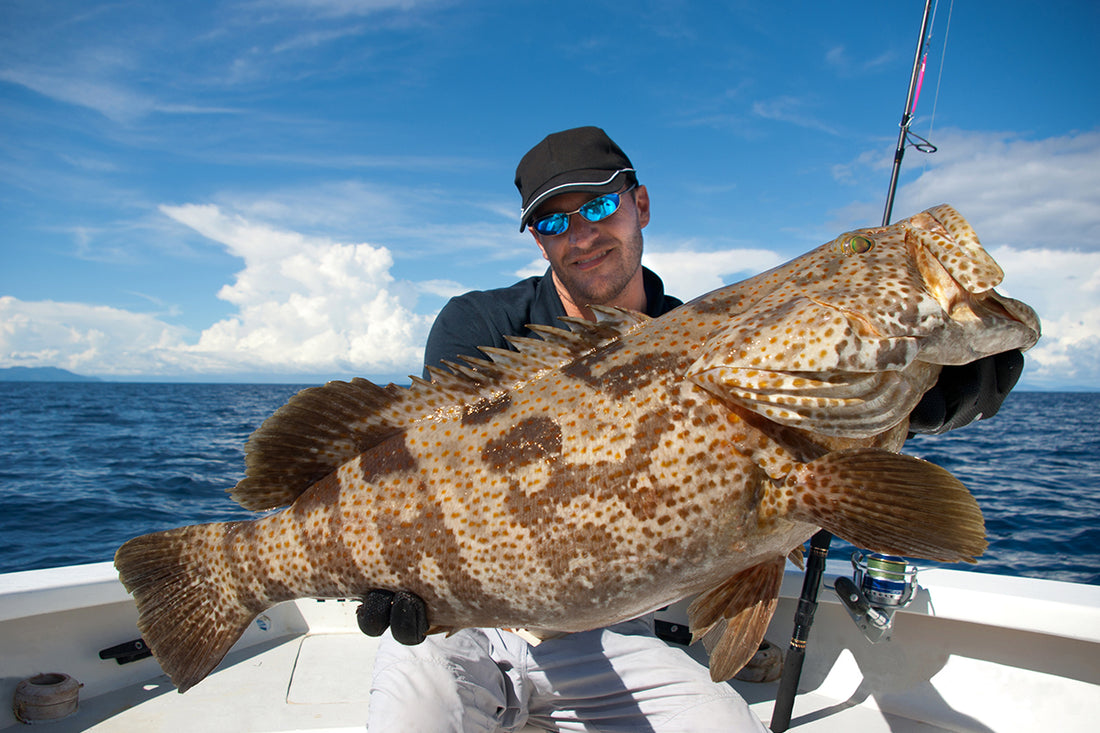Deep Drop Fishing is the key to an exciting world!
Deep beneath the ocean's surface is a world teeming with mysterious and elusive creatures that few people ever experience. Deep drop fishing is your key to this world. It’s far from your typical day on the water. Deep dropping requires advanced equipment, keen intuition, and a willingness to take on the unknown. This guide will cover what deep drop fishing is, what you can catch, and how to fish with metered color braid, an essential for getting the best results.
What Is Deep Drop Fishing?
Deep drop fishing involves targeting fish that live in the deeper parts of the ocean, often at depths ranging from 400 to 1,500 feet. This technique requires specialized equipment, including heavy-duty rods, reels, and metered color braid to handle the extreme depths and pressures.
Deep drop fishing lets you catch species that few anglers ever see because these fish live in the ocean's depths. They often inhabit specific underwater structures, seamounts, or trenches.
What fish do you catch with deep drop fishing?
- Tilefish: Including golden tilefish and blueline tilefish, both sought after for their flavor
- Groupers: Including warsaw grouper, which can weigh over 500 pounds, and snowy grouper, with light spots and wonderful taste
- Snappers: Including yellow eye snapper, named for their distinctive yellow eyes, and queen snapper, a bright red species of tender fish with a mild flavor
- Swordfish: Highly prized sport fish known for their long, sword-like bills and intense fights
- Wreckfish: Often found around deep underwater wrecks and structures, they're known for their firm texture
- Oilfish: Known for its oily texture, this species is often found in very deep waters
- Sablefish: Also known as black cod, sablefish inhabit deep waters and are prized for their rich flavor
- Orange Roughy: A deep-sea species that can live for over 100 years, known for its delicate taste
Finding the Right Spot for Deep Drop Fishing
Finding the ideal deep drop fishing spot requires combining technology, experience, and understanding of the marine environment. Modern GPS and fish finders equipped with sonar are essential tools for locating promising spots. GPS allows you to save coordinates of productive areas, while fish finders provide real-time data about the underwater terrain and potential fish presence.
Fish often gather around features that provide cover, a break in current, or abundant food sources. This includes rock formations, deep-sea trenches, and underwater mountains. As you gain experience, you can identify these spots on your fish finder.
Preparing Your Bait for Deep Drop Fishing
Different deep-sea fish are attracted to different types of bait, and the correct bait can greatly influence your success. Knowing the species you're targeting helps in selecting the right bait. For example, snowy groupers prefer cut fish, while tilefish are more drawn to squid.
Fresh bait emits a stronger scent that can attract fish, so it’s often the best choice. However, quality frozen bait is also widely used and can be highly effective if properly thawed and prepared. Common bait options include squid, mackerel, bonito, and other fish that reflect the natural prey of deep-sea dwellers.
Deep drop fishing requires bait to withstand extreme pressure and be able to descend to significant depths. Cutting the bait into the right size and shape to fit the hook properly will help. Whether you use live or cut bait, it must be attached securely to the hook to resist the pull of the currents and the nibbling of smaller fish on its way down.
Equipment for Deep Drop Fishing
Because your equipment will need to hold up to extreme conditions — and hopefully heavy fish — all of your gear needs to be durable, strong, built to withstand the most aggressive fish, and specialized for deep water.
Rods and reels
Deep drop rods are designed to withstand the intense pressures and demands of this specialized form of angling. Deep drop rods are usually constructed from a combination of fiberglass and graphite. This blend of materials ensures that the rods are both strong enough to handle the heavy weights required for deep-sea fishing and flexible enough to fight large, powerful fish.
Despite their robust build, deep drop rods must have sensitive tips so you can detect subtle bites, often through hundreds of yards of line. Deep drop rods are designed with a heavy to extra-heavy action, meaning they bend less and have more backbone. This stiffness enables them to handle the demands of heavy weights and substantial fish without breaking or losing control.
The Blackfin Rods Fin 154L is ideal for deep drop fishing due to its high-quality construction, strength, and sensitivity.
Regarding reels, many anglers prefer conventional models with high line capacity and robust drag systems, while others prefer the convenience of electric reels. The drag must be smooth and adjustable to manage a fish's powerful runs. Deep drop reels must accommodate a substantial amount of line, often several hundred yards, to reach the targeted depths. The reels must be constructed with materials resistant to saltwater corrosion and capable of handling the constant pressure exerted by heavy weights and large fish.
Metered color braid
Metered color braid, also known as multi-colored or segmented braid, is the best deep drop fishing line for catching tile and many other deep water fish. Metered color braid consists of different colors that are repeated at specific intervals along the length of the line. It's typically constructed from synthetic materials such as polyethylene, which provide high strength and low stretch.
The primary purpose of color coding is to allow you to gauge depth or distance without relying on electronic equipment. By knowing the color sequence and the length of each colored segment, you can accurately determine how much line you’ve deployed by counting the color changes. You can precisely position the bait at the desired depth or distance from the boat.
In deep drop fishing, metered color braid provides a significant advantage in targeting specific depths where fish may lurk. Its low stretch ensures you can feel bites and set hooks more effectively, even at great depths. FINS metered color braid provides superior performance for deep drop fishing.
Hooks and rigs
You’ll need robust and sharp hooks that can penetrate the tough mouths of deep-sea fish. Circle hooks & Circle Hook Rods are widely used due to their design, which promotes secure hooking without gut hooking the fish. J-hooks are also common but require a more aggressive hook set. The hook's size, shape, and strength must align with the targeted species and bait used.
Your rig should be tailored to the conditions and species. Glow beads, deep-sea fishing lights, or luminescent skirts can be added to the rigs to mimic bioluminescent prey and attract fish in the dark depths.
Single-hook rigs are straightforward and used when targeting a specific species that requires a particular bait presentation. The hook is often attached to a heavy monofilament or fluorocarbon leader.
Multi-hook rigs are more complex than single-hook setups, but they allow multiple baits to be presented at varying depths simultaneously. These are popular for targeting different species or when the exact depth of the fish is unknown.
Weights and sinkers
Deep drop fishing requires significant weight to get the bait down to the desired depths quickly. You can use bank or pyramid sinkers. The weight must be heavy enough to overcome underwater currents but not so heavy that it makes detecting bites difficult.
How to Fish with Metered Color Line
 When you fish with metered color line, you’ll use the color-coded segments to accurately measure and control the depth of your bait. This precision and control can significantly improve your success rate. Here’s the step-by-step process:
When you fish with metered color line, you’ll use the color-coded segments to accurately measure and control the depth of your bait. This precision and control can significantly improve your success rate. Here’s the step-by-step process:
- Select your line: Choose a metered color line with appropriate color segment lengths and pound test for the specific type of fishing you are planning.
- Spool the reel: Spool the metered color line onto your reel, ensuring it’s evenly distributed. The line should be wound tightly and without twists to prevent tangles during deployment.
- Attach the leader: Connect a monofilament or fluorocarbon leader to the metered braid using a suitable knot or connector. The leader provides a clear connection to the bait and adds some stretch as a shock absorber.
- Rig the bait: Attach your bait or lure to the leader. In deep drop fishing, you may use a multi-hook rig with heavy weights to reach significant depths.
- Deploy the line: Begin letting out the line, pay attention to the color changes. Each color change indicates a specific distance or depth based on the length of the color segments. Use the color segments to accurately gauge how much line you've let out and the depth of your bait. The count of color changes will tell you the exact distance from the reel to the bait.
- Find the right depth: Once you've reached the desired depth, engage the reel and wait for a bite, keeping a keen eye on the line and rod tip for any signs of activity.
- Strike and retrieve: Set the hook with a firm but controlled motion when you detect a bite. The metered line's low stretch will help with effective hook setting. Reel in the fish, being mindful of the weight and the resistance. The color changes on the line can also help you gauge how far the fish is from the boat.
Safety Considerations
Deep drop fishing involves venturing into deep ocean waters — often miles offshore — and presents unique safety challenges. Always check weather forecasts and sea conditions before heading out. Deep-sea conditions can change rapidly, so knowing what to expect and having contingency plans is essential.
Before you head out, make sure your boat is in proper working order and equipped with the necessary safety equipment, such as life jackets, fire extinguishers, flares, and a first aid kit. Wear suitable clothing, including non-slip footwear, sun protection, and potentially foul weather gear if conditions warrant.
Finally, use gloves and protective eyewear when handling hooks, rigs, and other sharp equipment. As long as you’re well prepared and use the right equipment, deep dropping will be the adventure of a lifetime.
Questions? Comment below or contact us today!


